

Untitled. Untitled. How thawing permafrost could fuel climate warming The Arctic is warming more than twice as fast as the rest of the world, and some scientists believe that thawing permafrost — ground frozen since the last Ice Age — is about to release enormous amounts of climate-warming emissions.
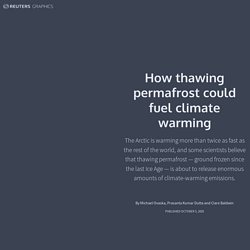
Just centimeters below the Earth’s surface is a ticking time bomb that could detonate as global temperatures rise. It's called permafrost. Permafrost is found at high altitudes in mountains such as the Himalayas, the Andes and the Southern Alps of New Zealand, as well as at the poles in Antarctica and, especially, in the Arctic. Permafrost is a lot like concrete. Now, human-induced climate change – caused by the buildup in the atmosphere of greenhouse gas emissions from industrial activity, mainly the burning of coal, oil and natural gas - is raising global temperatures and driving heat waves that can cause permafrost to thaw. How bad will it get? Bruce Parry eats raw liver and eyes from a seal - Snotr. Going to Extremes - Cold (1/4) Tundra Biome: Informational Video. Growing up in -60C. Image copyright Brice Portolano Fifteen-year-old Ayal is the last of his siblings still living with his mother in the small village of Verkhoyansk, in the east of Russia.
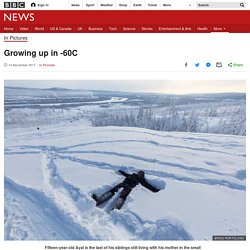
In a few months, he plans to follow his four brothers and sisters to study in the city of Yakutsk, more than 600km (373 miles) away from his hometown. Although Verkhoyansk has a 3G antenna, meaning the teenagers can share their lives on Instagram and discover the world more easily, it's increasingly common for them to leave for the bigger cities. Photographer Brice Portolano documented Ayal as he waits to depart, splitting his time between school, his computer, and on solitary walks through the frosty landscape of his village. Divorced, Ayal's mother raised her five children on her own. Brazil opens vast Amazon reserve to mining. Image copyright Getty Images Brazil's government has abolished a vast national reserve in the Amazon to open up the area to mining.
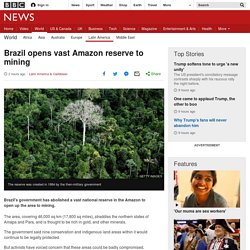
Climate change is turning Antarctica green, say researchers. Antarctica may conjure up an image of a pristine white landscape, but researchers say climate change is turning the continent green.

Scientists studying banks of moss in Antarctica have found that the quantity of moss, and the rate of plant growth, has shot up in the past 50 years, suggesting the continent may have a verdant future. “Antarctica is not going to become entirely green, but it will become more green than it currently is,” said Matt Amesbury, co-author of the research from the University of Exeter. “This is linking into other processes that are happening on the Antarctic Peninsula at the moment, particularly things like glacier retreat which are freeing up new areas of ice-free land – and the mosses particularly are very effective colonisers of those new areas,” he added.
Topher White: What can save the rainforest? Your used cell phone. Should tourists be banned from Antarctica? This season around 37,000 tourists are expected to visit Antarctica - home to about 20 million pairs of breeding penguins.
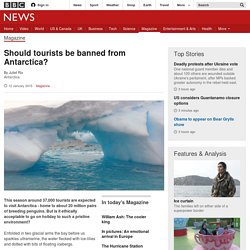
But is it ethically acceptable to go on holiday to such a pristine environment? Enfolded in two glacial arms the bay before us sparkles ultramarine, the water flecked with ice-lilies and dotted with bits of floating icebergs. A sheer cliff towers dark above us, flanked by snow slopes as pure white as the glistening fronts of the little Adelie penguins whose spectacled eyes peer curiously around as they waddle and toboggan about their business just a few feet away. This is Brown Bluff on the Antarctic Peninsula and togged up in layer upon layer of fleece, topped with vivid red wetskins I am all too aware that this is not my habitat. Which begs the question: Should I be here? Nonetheless, he argues, carefully controlled tourism is not just OK but useful. Not everyone is convinced the benefits outweigh the risks but most are pragmatic. Belo Monte, Brazil: The tribes living in the shadow of a megadam.
Science Cuts Deep Into The Mystery Of Antarctica’s Bleeding Glacier. TRS_Blog_DTOP_BelowTitle_336x280.
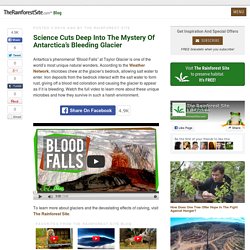
South America: Physical Geography - National Geographic Education. South America, the fourth-largest continent, extends from the Gulf of Darién in the northwest to the archipelago of Tierra del Fuego in the south.
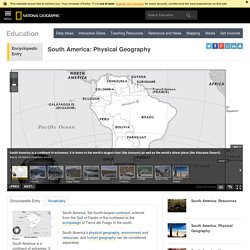
South America’s physical geography, environment and resources, and human geography can be considered separately. South America can be divided into three physical regions: mountains and highlands, river basins, and coastal plains. Mountains and coastal plains generally run in a north-south direction, while highlands and river basins generally run in an east-west direction. South America’s extreme geographic variation contributes to the continent’s large number of biomes. A biome is a community of animals and plants that spreads over an area with a relatively uniform climate. Within a few hundred kilometers, South America’s coastal plains’ dry desert biome rises to the rugged alpine biome of the Andes mountains.
With an unparalleled number of plant and animal species, South America’s rich biodiversity is unique among the world’s continents.